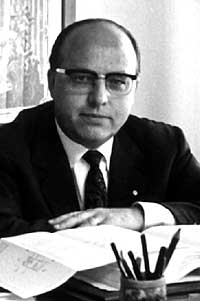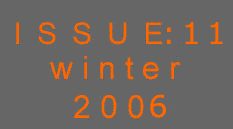
In Memoriam: Professor Carlo Salvetti
(1919 – 2005)
In February last year, the European nuclear
community lost one of its most respected and distinguished
friends. Professor Carlo Salvetti sadly passed away on
11 February, aged 86, while still serving as Vice President
of the Italian Nuclear Socity (AIN – Associazione
Itliana Nucleare). ENS NEWS would like to pay tribute
to the inestimable contribution that Carlo made during
a lifetime spent furthering the cause of nuclear science
and the nuclear industry in Italy. The best possible way
of paying tribute to Carlo, his contribution and his legacy,
is to give the final word to those who knew him best.
Enrico Mainardi and Ugo Spezia, two members of AIN and
ENS, take an affectionate look back at the life and times
of one of Italy’s leading nuclear pioneers and a
redoubtable supporter of the nuclear industry. Their story
begins in 1945, the day after the first nuclear bombs
were dropped on Hiroshima and Nagasaki. Enrico and Ugo
take up the story……
|

Professor Carlo Salvetti
|
“The day after the first nuclear bombs
were dropped on Japan, Girogio Valerio and Vittorio De Basi -
President and Managing Director of Edison - asked Mario Silvestri
to investigate the possible future development of nuclear energy.
Sivestri was joined by Professor Giuseppe Bolla and his two young
assistants, Giorgio Salvini and a 27-year ole researcher called
Carlo Salvetti. In the spring of 1946, Salvini and Salvetti proposed
a three-step research programme. The first step was to create
a group of research experts. The next step was to build a zero-power
atomic battery, like the one CP-1 developed by Fermi, in Chicago,
in 1942. The final step was to build a mini reactor, “made
in Italy.”
At that time, the peace treaty that put a final
end to World War II was being finalized in Paris. In September
1946, Bolla, Silvestri, Salvini and Salvetti set off for Paris
to find out whether, among the numerous clauses of the peace treaty
there was anything that prohibited the development – for
peaceful purposes - of nuclear. The four colleagues had no official
mandate for being there and didn’t know who to speak to.
Silvestri decided, for want of a better alternative, to contact
a journalist he knew at the Italian daily Corriere della Sera,
which was accredited to the official Italian delegation to the
Paris peace treaty negotiations. The journalist put them into
contact with a member of the Italian delegation, Ivanoe Bonomi,
the ex-Prime Minister of Italy. The ‘group of four”
visited Bonomi. Although Bonomi knew very little about what they
were talking, he gave them a copy of the draft peace treaty. The
treaty revealed that the Belgian delegation had insisted that
a clause forbidding the military use of nuclear be included. The
four Italian researchers told Bonomi to adopt a low profile on
this point and only to discuss it if the intention was to forbid
nuclear was extended to include peaceful applications of nuclear
energy.
Once back in Italy, our four intrepid researchers
lobbied the management of Edisonvolta and persuaded them that
investing in nuclear would be a good business move. As a result,
a special research company called CISE (Center for Information,
Study and Expermentation) was formed, in Milan, in November 1946.
Carlo Salvetti later recalled “I thought at the time that
it was better not to reveal too much about what we were doing.”
The creation of CISE was the first step in the
development a nuclear industry in Italy and it was private industry
that started the ball rolling. Originally, three private companies
were involved in creating the fledgling industry, Edisonvolta,
FIAT and Cogne. Four more companies later joined the enterprise,
Montecatini, the power generating company SADE (Societa Adriatica
d’Elettricita), Pirelli and Falck.
From the outset, CISE was able to enlist the
support of eminent physicists like Edoardo Amaldi (part of a Roman
team led by Fermi), Gilberto Bernardini and Bruno Ferretti. Amaldi,
Bernardini, Ferretti were joined on the Board of Directors of
the newly-formed CISE by De Biasi and Gustavo Colonetti, president
of the CNR (National research Centre). Unfiortunately, the CNR
were not able to support the venture with funds for research.
The final piece in the CISE jigsaw puzzle was the hiring of Felice
Ippolito, a geologist who specialized in minerals. Ippolito brought
with him the support of the steel company Terni, which was chaired
by his father, and of the power generating companyr SME (Societa
Meridionale d’Elettricita).
In 1952, the CNRN (the National Committee for
Nuclear Research) was created. The CNRN then became known as the
CNEN (the National Committee for Nuclear Energy). Finally, the
CNEN became known as ENEA (Ente per le Nuove Tecnologie, l'Energia
el'Ambiente). Prior to 1952, CISE was the only Italian research
institute dedicated to the advancement of nuclear technologies
and to the development of a genuinely independent nuclear research
programme.
In 1957, anticipating the lack of funding that
was inevitably going to affect CISE and limit its chances of developing
nuclear technology, Carlo Salvetti decided to join the CNRN. Carlo
was responsible for developing the Ispra Nuclear Centre and became
its first Director General. Ispra later became part of Euratom
and remains today one of the European Commission’s Joint
Research Centre facilities. Carlo was against the move from the
start and strongly criticized the “handing over” of
Ispra to Euratom.

|
In 1959, Carlo was named
Director of Research and Laboratories at the UN’s
International Atomic Energy Agency (IAEA), in Vienna. From
1962-1970, he was Governor of the Italian delegation to
the IAEA and President of the Governors’ Council from
1963-1964. |
Carlo Salvetti was then elected Vice president
of the CNEN and entrusted with the job of rebuilding the organization.
From 1963-1980, Carlo worked tirelessly at the CNEN. The President
of the CNEN was also the Italian government’s Minister for
Industry. Italy invested strongly in nuclear energy and these
were undoubtedly the halcyon days of the Italian nuclear industry.
Professor Carlo Salvetti devoted sixty years
of his life to the cause of nuclear research and to the development
of the Italian nuclear industry and was still active when he died,
in February last year. Thanks to his enormous contribution, a
whole generation of physicists and nuclear engineers has been
nurtured and trained. This is part of his enduring his legacy.
His pioneering spirit, enthusiasm and dedication made him a unique
figure in post-war Italian research.
Before he died, Carlo learnt that the current
Italian Prime Minister, Silvio Berluscone, had advised that the
nuclear debate in Italy should be reopened after years of stagnation
following the Chernobyl-inspired moratorium on nuclear energy.
He must have thought “about time too…too little too
late.”
To say that Carlo will be sorely missed is an understatement of
nuclear proportions.
|







